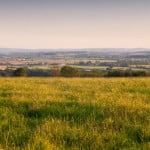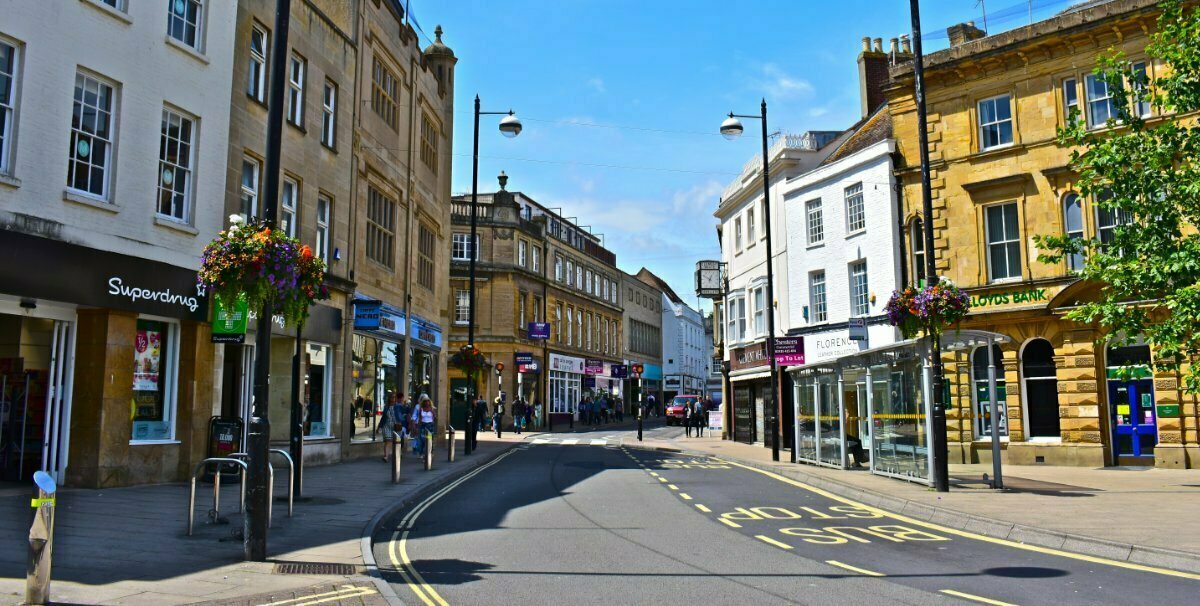
Yeovil The Home Of The Glovers
Still, it is quite pretty in parts, has some nice shopping locations and of course, a football team nicknamed the Glovers! So if a trip to the South West interests you then read on and see wha6y Yeovil has to offer. Lets begin with a bit of history…
Yeovil Way Back Then!
Yeovil has likely been inhabited in one way or another since the Paleolithic Period (the early Stone Age). This is evidenced by archaeological excavations which have uncovered burial sites dating from this period. Settlements would have dotted the area, given there is plenty of flint that they could have carved tools from. There has also been Bronze age relics found, most famously a gold torc discovered in 1909 in the Hendford region of the town.
The Yeovil History website records that the Durotriges were the tribe that lived in this land before the Romans came. They lived at Ham Hill – a nearby flint quarry – from 1 BC onwards. The Romans formally invaded in 43 AD and built the main road in the region, the Fosse Way, which runs through the town and a settlement sprung up near what is now known as Westland Road. They would have left before the end of the 2nd century because Rome was in turmoil.
Not much is known about the immediate aftermath but we do know that in 880 Yeovil was mentioned in a Saxon text, by the name Gifle and it formed part of the estate of Alfred The Great. The now imposing St Johns Church in the town centre originates from this era and was mentioned in King Alfreds will in 899AD. It has of course had a few alterations over the years. It is now a Grade I listed building.
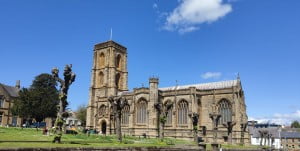
Image rb3legs/Shutterstock.com
The Doomsday Book
The next time it would be mentioned was in the Domesday Book. King William the Conqueror granted the land to the Count of Eu, who later passed it to his descendants. They held it until the 16th century. The land contained 36 households and was one of the largest 40% of all recorded. The area is recorded as having two owners: the Count Robert of Mortain and William of Eu.
William of Eu owned 6 ploughlands and 7 teams to plough them with. He had 30 acres of pastureland and 33 of meadowland. He had cattle, pigs, and sheep. Count Robert had 4 smallholders, 3 ploughlands and two teams, 1 mill, and kept pigs, cattle, and sheep. In 1086, the area of Yeovil was a busy market town with plenty of nobility lurking in the countryside.
Medieval Yeovil
During the next few hundred years, Yeovil would resort to being a sleepy, slow-growing town. In 1205 King Richard granted them a charter to hold their own market. It would have allowed them a yearly fair, too. The above mentioned St John’s Church was extended during the 1300s and in 1343 there were riots in Yeovil against the officers of the church. The Diocese lived well while the people were poor.
The Black Death struck between the November of 1348 and the May of 1349. It came in three distinct waves and generally wiped out about 20% of the population of most towns. However, Yeovil suffered badly losing around half of its population. It was the area of Somerset was where the plague first struck and, the church lost a full third of its clergy. The bishop recorded it was an emergency probably as the collection plate was looking a bit light.
The people looked to the church for answers and saw that they were as mortal as everyone else. This led to more riot, and in 1349 the Bishop of Wells was stranded in the church while his priests were violently attacked in the market. Still, things recovered soon enough and in the 1400s the town had reached such a high status that they were given the right to elect their own Portreeve – a high ranking official that reported to the crown.
Things were looking good until…
The Great Fire of Yeovil
In 1499 a major fire took out most of the town. Fires would strike again in 1620 and 1643 before they got the message and started tiling the roofs instead of thatching them. The population in 1499 was likely around 1000 people. From those times the making of gloves became an economic player in Yeovil. The 10th century Church of St. Johns was rebuilt in 1400 and in 1477 almshouses were built by John Woburn, who paid for them in his will.
There was a priory in town which Henry VIII would later tear down. Another outbreak of plague did serious damage in the years 1646 and 1647. People in Yeovil made paper and gloves. The market sold cheese, hemp, and linen threads. Later in the same century, the Duke of Monmouth held a rebellion against the king, but he was defeated at the Battle of Sedgemoor. His supporters were later executed in Yeovil using that favoured English execution technique of being hung, drawn, and quartered.
That seems like a pleasant enough place to stop for the moment. Let’s look at some Yeovil trivia in the hopes that it is a little more light-hearted.
A Bit Of Yeovil Trivia
Every one of our travel guides to local places contains fun and or interesting facts you really ought to know about the area. Here are some of the fun facts and not-so-fun trivia that we dug up about Yeovil.
- 8 men were hung, drawn, and quartered here in 1685 thanks to the duke.
- Yeovil was part of the Hundred of Stone, back when the monarchy controlled us in groups of hundred.
- Yeovil was called Gifle for so long that King Alfred’s will records it as such. In 1673, it was also recorded as being spelled ‘Evil’. We hope that was for short…
- The Buffalo Bill show visited Yeovil in 1903 – that’s right. The real Buffalo Bill.
- Yeovil is the sight of some of the UK’s first vehicle manufacturing plants and was excessively targeted in WWII because it had an aeroplane building plant nearby.
- In the 70s, the man who owned the shop ‘the Cooker King’ kept a one-eyed lioness in his backroom. We are honestly not making this up, look. People would call him the lion king of Yeovil because he would walk ‘Tara’ in the streets. The entry reads that he also kept a camel named Jasmine.
- There is a Yeovil in Johannesburg, named by a former Yeovil man. The region gave shelter to Nelson Mandela when he was on the run in the 60s.
- Yeovil is twinned with Herblay, Taunusstein and Samarate. The town is proud of its European links and they even display them on the sign welcoming people in.
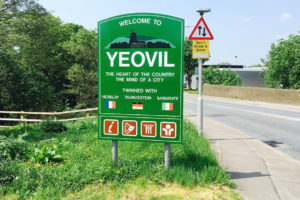
Image: Imran Khan Photography/Shutterstock.com
Wow. Yeovil really is an interesting place. We still can’t get over the lioness. Nevertheless, we move onwards. Let’s get back to the Industrial Era history of the town.
Industrial Era Yeovil
Industrial Yeovil was the glove-making capital of the UK. The Victorians loved a good glove, but most of those bought and sold were made here. In 1744, a school was opened but it would have been for boys only. By 1801, the population had grown to be about 2,800 people.
In 1830 a town commission was set up and they would go on to add lights, pavements, and generally clean things up. By 1834, a gas works had moved into town, allowing the oil lamps to be replaced with gas street lighting. A riot in 1831 was caused by parliament refusing to reform the way elections worked. They were not the only ones. There were riots in London, Nottingham, Derby, Worcester, Bath, Exeter, Sherborne, and Leicester. The Yeovil records deem the rioting due to the Whig’s candidate not being elected. They only ended when authorities were called in to make arrests.
The railway line was built to Yeovil in 1853 and the Town Commission rebuilt most of the town centre and the town hall in 1849. In 1856 the town became its own borough and was given a Mayor. A hospital was built in 1872 and piped water arrived around this time along with proper Ssewers which helped improve public health.
By 1888, cheese and butter were the town’s newest big products but glove making was still going strong. In the 1880s, the Petters brothers would open their factory and make the UK’s first-ever oil combustion engine. A nice achievement to end the 19th century on.
Modern Era Yeovil
In 1901 the population of Yeovil was 11,000 – about four times what it was a hundred years before. The town hall was built in 1926 and subsequently burnt to the ground in 1935.
In WWI, Yeovil had its supply of horses commandeered to be used on the front lines. More than 300 young men from Yeovil would die abroad, almost half of the 698 who signed up from the area. A war memorial was placed in town in the 20s to commemorate their great sacrifice.
During WWII, the town was targeted thanks to its association with vehicle and aeroplane manufacturing. It is estimated that 107 high explosive bombs were dropped here, about five times the amount we have heard of being dropped on towns of larger sizes around the London area. The worst period of the bombing was in 1942. The bombs damaged 2,377 recorded homes while killing 49 people and injuring many more.
In 1962 the town gained a fire station. That seems very late for a town that kept catching fire. Yeovil College was first opened one year later, and the Museum of South Somerset opened in ’65. A second hospital was added in 1973, replacing what was already there. The town’s Octagon theatre opened in the 70s, just before glove-making went into decline in Yeovil. At its height, 3 million pairs were made in the 1830’s.
Today gloves are a thing of the past and the towns main employer is defence contractors, with Helicopters being the biggest contributor.
Famous People from Yeovil
Before we move on to the best bits about visiting or living in Yeovil, let’s review the most famous faces you might spot here. Some famous people from Yeovil are:
- Lieutenant General Sir Charles Knight Pearson the Colonel in Command during the Siege of Eshowe in the Anglo-Zulu War of 1879.
- Heather Mary Stanning OBE & Coxless Pairs Rower won Team GB’s first Gold Medal at the 2012 Summer Olympics. This was also Great Britains first ever Olympic gold medal win in women’s rowing. Also done in then Olympic Record time!

The Royal Mail commemorated the occasion with these special stamps
- 2014 England Women’s Rugby World Cup winner Marlie Packer is from Yeovil. She has been awarded the freedom of the town.
- If music is more your thing then you may remember James (Jim) Cregan who was a member of Glam Rock Band Steve Harley & Cockney Rebel (who are still going strong) in the 1970s.
And here are a few more for good measure:
- Jane Arbor who famously wrote Mills and Boon romances.
- Footballers Martin Cranie, Rob Burch, and Chris Meyers.
- Cricketers Jonathon Harvey and Tom Brock.
- Sarah Parish from Peak Practice is from here.
- The Petter Brothers, famous for that oil combustion engine.
- Vanessa White from the Saturdays used to live here.
Things to do in Yeovil
Here are the best things to do in Yeovil, as voted for by local guides.
Historic sights and Landmarks
One of the best historic/museum places in Yeovil is out at Dawe’s Twineworks. All those gloves needed threads to stitch them together and it was made in the town too. This place is fully working with original Victorian Era machinery. They do school groups and individual tours which won’t be a waste of time.
The Treasurer’s House is a local landmark of some notoriety. This place is ancient. It’s built to resemble a church and will make a great place for Instagram photos. It was erected in the 1200s and features a small medieval house with a long hall attached to it. Long halls were Danish in origin as they came with the Vikings. They would build long halls instead of houses, and that’s where they would entertain, eat, sleep, and live. It’s lovely to see that there is a surviving 13th-century long hall in the middle of Somerset. Worth the trip. We’re not sure why it’s called the treasurer’s house, though.
Galleries and Museums
The Yeovil Railway Centre is a popular museum for the kids in the town. It’s a speciality museum with railways and trains as the target. They are super-busy at Christmas when Santa himself makes a pitstop here for a few days. They have steam train days, which the little ones adore. You can even book a driving experience on a steam train provided you are old enough (and rich enough) to afford it. This place ticks all the train junction boxes for adults and kids alike… but especially those adults who love trains.
Check out the Fleet Air Arm Museum while you are in Yeovil. It is billed as being the Royal Navy’s largest collection of Naval Aviation pieces. Meaning this is the navy’s plane museum, which is a bit weird. They use them though, otherwise why the need for aircraft carriers? Anyway, go along and see the planes. They’re extravagant and awesome.
Outdoor Attractions
A favourite attraction for children, head down to the Cary Alpaca farm. They offer alpaca treks and petting, they are based in the Somerset countryside, and they provide a relaxed alpaca experience that is good for kids who like sensory toys. Alpaca wool is softer than soft and, if they don’t kick you, it’s a great day out. They’re not known to kick, don’t worry.
Another favourite for the little ones is Ninesprings Country Park. This place is a haven for animals and wildlife, and kids just can’t get enough of the birds. This is a nature park and walking trail that takes you past a tearoom, a river, and through some woods. Follow it far enough and you will reach the Yeovil Country Park, farther south.
Yeovil Country Park is our third and final place to see outdoors near Yeovil. The Park is reasonably new, having been built in 2002 and not by the Victorians like all the other public parks in England. It is only five minutes’ walk from the town centre, making it a favourite place to meet for coffee and a walk. While Ninesprings has lots of footpaths, the Country Park is more focused on becoming a wildlife space than giving you plenty of walking options.
Recreation
Football
Yeovil Town FC or the Glovers is the local team and will always be remembered for their epic 1948-49 FA Cup exploits on their then famous sloping pitch at Huish Athletic Ground. Their exploits against then Mighty Sunderland was no one-off though and before they joined the Football League in 2003 they held the record for the most FA Cup giant-killing results. They are currently back in the non-league, but they did get as high as the Championship (tier two)! They currently play at the relatively modern Huish Park, and we can attest it’s a good day out for any true Football fan.
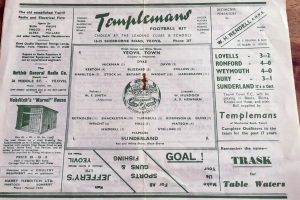
One of the biggest FA Cup upsets ever Yeovil 2 Sunderland 1!
Other Things
The Octagon Theatre was built all the way back when Yeovil was an Industrial glove-making town. To this day, it is still one of the top attractions. You can catch many kinds of shows here, from theatre to live gigs. Look at the program on a weekend to get a good feel for what will be playing when you’re visiting.
There’s a Ready 2 Climb climbing centre in Yeovil. That’s right, the one where they strap you up and you climb the wall in a harness, then they catch you if you fall. Not for those that suffer from vertigo but still a fantastically fun day out. They offer lessons, run workshops, and even take group bookings if you’re looking for something fun to do for a stag or hen night.
Yeovil Golf Club is the solitary golf club in this town. It must be the only town in England that doesn’t have three golf clubs within stone throwing distance. We are shocked Yeovil, shocked to our very core.
Shopping and Retail
The best shopping centre in Yeovil is the Quedam Shopping Centre, although, to be fair, Yeovil is light on shopping. When the glove manufacturers moved out, they left industrial spaces instead of retail ones. Nevertheless, The Forum is just outside of town and this retail park serves the wider area too. They have a Pandora, a Monsoon, and all the usual higher-end shops.
Other Notable Yeovil Attractions
In this section, we attempt to squeeze in all the other bits that we missed before. If you are in town for longer than a day or two, check out these:
- Tintinhull Garden is fantastic. If you can’t handle the big walks of the country parks, a garden like this is perfect.
- Take the kids to the Yeovil Recreation Centre
- Drop in on Yandles Arts and Crafts and have tea or make something.
- Visit the Yeovil independent market once a week.
- Take a tour at the Somerset Cider and Brandy Company.
- Try and find Abbey Barn & Abbey Farm House – Yeovil’s other Grade One Listed Buildings.
And so much more. Get out there and explore Yeovil. You won’t regret it!
How to get to Yeovil
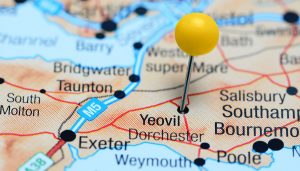
Image: Dmitrijs Kaminskis/Shutterstock.com
Here’s how you get to Yeovil, very roughly anyway. The postcodes for the town are BA20, BA21 & BA22 if you want to get your sat nav out.
By Road
Follow the M5 south out of London, or west. It is also served by the A37 & A30, and the A303 is pretty close too.
Train Services
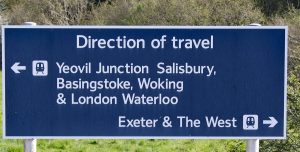
Image: Gartland/Shutterstock.com
Although there are two stations serving the town, neither are what you would call centrally placed. Yeovil Pen Mill Station is closest to the town centre, being around a mile out and is on the Bristol to Weymouth line making it your quickest route to the seaside if you are a local. It was opened in 1854 and if you are planning to fly as part of your visit very useful as the nearest airport is Bristol.
The other station serving the town is Yeovil Junction, which is actually in the nearby village of Stoford having opened in 1860. It is located on the London Waterloo to Exeter line and gives fairly quick access to the Capital. It is around two miles away from the city centre, but there are regular busses to and from it.
Air Links
Yeovil despite being a sizable town has no airport in the vicinity. So if you want to pay a flying visit, think Bristol, Bournemouth or Exeter in that order (Traveling distance-wise anyway).
By Boat
If you can sail the Yeo, you can reach Yeovil.
Where to stay?
Given that Yeovil is the largest town in South Somerset finding overnight accommodation is not a problem. There is an abundance of hotels and guest houses both in the town and nearby. Most of the hotels are a few miles away from the town centre though. There is a Premier Inn in the town centre though and there is a travel lodge on the roundabout on the A303.
If Self catering is more your thing then there are a number of Airbnb listings you could try too.
Thinking of Moving Here
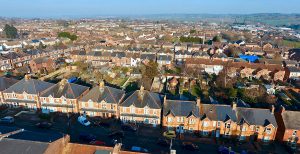
Image: Imran Khan Photography/Shutterstock.com
Slightly surprisingly the average house price in Yeovil is well below the Somerset average. At the time of writing (09/2021) Zoopla estimates this at £301,657 for the county as a whole and £261,403 for the town itself. That’s a substantial discount, but probably reflects the makeup of the local housing stock more than any regional discount.
This was identified by the South Somerset Council in a 2017 paper which showed that only 20.3% of the towns housing stock was classed as Detached as opposed to 32.3% for the county as a whole. This will obviously skew the averages.
Still, this is well below the national average and given the lovely countryside and the reasonable employment prospects it is one we would consider should the urge to move south ever come over us.
Got Five Minutes?
So there we have it our quick overview of this surprisingly interesting place. Remember to put it on your itinerary when in the area next, or if planning a South West staycation. Not the place for you? then why not check out our other travel guides or have a browse around the rest of the site as we try to have something for everyone.


